Chcesz przenieść twoją witrynę WordPress do nowej domeny?
Zmiana nazwy domeny twojej witryny internetowej może znacząco wpłynąć na rankingi SEO, więc jest to proces, który należy przeprowadzić bardzo ostrożnie.
Chociaż nie można uniknąć tymczasowych wahań SEO podczas migracji twojej witryny internetowej do nowej domeny, można zminimalizować ich wpływ i szybko odzyskać ruch i rankingi wyszukiwania.
W tym przewodniku pokażemy prawidłowy sposób przeniesienia WordPressa na nową domenę bez utraty SEO.

Migracja twojej witryny WordPress na nową nazwę domeny może być przerażająca, ale nie musi. Jesteśmy tutaj, aby przeprowadzić Cię przez każdy etap tego procesu.
Możesz kliknąć dowolny z poniższych odnośników, aby przejść do konkretnego kroku migracji twojej witryny WordPress do nowej nazwy domeny:
- What to Know Before You Change Domains
- Pre-Steps: What You Need to Get Started
- Step 1: Create a Duplicator Package of Your WordPress Site
- Step 2: Create a Database for Your New Domain Name
- Step 3: Unpack WordPress on Your New Domain Name
- Step 4: Set Up Permanent 301 Redirects
- Step 5: Notify Google About Your New Domain
- Notify Your Users About the New Domain Name
Film instruktażowy
Jeśli wolisz pisemne instrukcje, czytaj dalej.
Co należy wiedzieć przed zmianą domeny
Zanim zaczniesz, powinieneś wiedzieć kilka rzeczy.
Proces przenoszenia do nowej domeny będzie miał tymczasowy wpływ na twoje rankingi w wyszukiwarkach, ponieważ Google i inne wyszukiwarki będą musiały dostosować się do zmian.
Tak, będzie to miało również tymczasowy wpływ na twój ruch z wyszukiwarek. Należy pamiętać, że jest to normalne i zdarza się wszystkim witrynom internetowym, które przechodzą na nową domenę.
Możesz jednak znacznie zmniejszyć wpływ na SEO, postępując zgodnie z tym przewodnikiem. Pokażemy ci właściwy sposób przenoszenia twojej witryny WordPress na nową nazwę domeny, konfigurowania odpowiednich przekierowań 301 i powiadamiania wyszukiwarek.
Należy pamiętać, że ten przewodnik nie dotyczy przenoszenia witryny WordPress na nowego hosta. Dotyczy on wyłącznie zmiany nazwy domeny. Chociaż proces jest podobny, istnieje kilka dodatkowych kroków. Te dodatkowe kroki pomogą ci zabezpieczyć twoje rankingi SEO i ruch.
Wreszcie, jeśli twoja stara witryna internetowa znajduje się na WordPress.com, musisz postępować zgodnie z instrukcjami w naszym przewodniku, jak przenieść się z WordPress.com na WordPress.org.
Kroki wstępne: Czego potrzebujesz, aby zacząć
W tym przewodniku zakładamy, że twoja witryna internetowa WordPress jest skonfigurowana na oldsite.com i próbujesz przenieść ją na newsite.com.
Zakładamy również, że posiadasz już konto hostingowe WordPress i jesteś zaznajomiony z panelem sterowania Twojego hostingu.
Będziesz także musiał wiedzieć, jak korzystać z klienta FTP, takiego jak FileZilla, lub jak edytować pliki za pomocą aplikacji Menedżer plików dostępnej w kokpicie twojego konta hostingowego.
Jeśli nie masz dostawcy hostingu lub chcesz zmienić dostawcę, zalecamy skorzystanie z Bluehost (świetny dla małych witryn + bezpłatna domena) oraz SiteGround lub WP Engine (świetne dla większych witryn lub sklepów internetowych).
Gdy masz już te rzeczy na miejscu, jesteś gotowy do rozpoczęcia procesu!
Krok 1: Utwórz pakiet Duplicator Twojej witryny WordPress
Pierwszą rzeczą, którą musisz zrobić, jest utworzenie pełnej kopii zapasowej twojej witryny WordPress.
Następnie użyjesz tej kopii zapasowej do utworzenia duplikatu twojej witryny internetowej, abyś mógł poprawnie skonfigurować przekierowania ze starej domeny do nowej.
Chociaż dostępnych jest wiele wtyczek do tworzenia kopii zapasowych WordPress, będziemy używać Duplicatora, który jest najlepszą wtyczką do tworzenia kopii zapasowych i migracji WordPress.
Uwaga: Dostępna jest również bezpłatna wersja programu Duplicator, której można użyć do tej migracji. Zalecamy jednak uaktualnienie do płatnego planu, aby odblokować więcej funkcji, takich jak automatyczne tworzenie kopii zapasowych w chmurze, odzyskiwanie witryn internetowych jednym kliknięciem, łatwiejsze migracje i wiele innych.
Zacznijmy od zainstalowania i włączania wtyczki Duplicator na twojej starej domenie. Aby uzyskać więcej informacji, zobacz nasz przewodnik krok po kroku, jak zainstalować wtyczkę WordPress.
Po włączeniu wtyczka doda pozycję menu Duplicator w twoim panelu administracyjnym WordPress. Musisz kliknąć menu Duplicator, a następnie kliknąć przycisk „Utwórz nowy”, aby utworzyć nowy pakiet lub kopię twojej witryny WordPress.
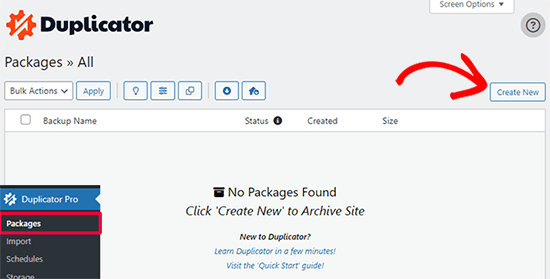
Duplicator zainicjuje teraz kreatora wstecznego i automatycznie przypisze nazwę do tego pakietu.
Kliknij przycisk „Dalej”, aby kontynuować.

Duplicator przeprowadzi teraz kilka testów, aby sprawdzić, czy wszystko jest w porządku. Jeśli wtyczka znajdzie problem, pojawi się ostrzeżenie z instrukcjami.
Jeśli wszystkie elementy są oznaczone jako „Dobre”, kliknij przycisk „Utwórz”.

Wtyczka rozpocznie teraz tworzenie pakietu Duplicator plików twojej witryny internetowej. Proces ten może potrwać kilka minut, w zależności od rozmiaru twojej witryny.
Po zakończeniu pojawi się opcja „Pobierz”. Kliknięcie jej spowoduje wyświetlenie opcji pobrania obu plików lub pobrania osobno instalatora i archiwum (zip).
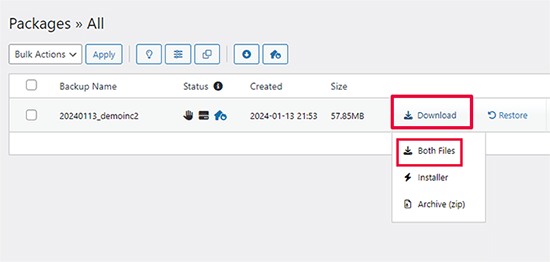
Wybierz „Oba pliki”, aby pobrać je na twój komputer.
Plik archiwum to kompletna kopia twoich plików WordPress. Obejmuje on twoje motywy WordPress, ustawienia bezpośrednich odnośników, wtyczki, przesłane pliki i wszelkie inne pliki utworzone przez wtyczki WordPress.
Skrypt instalatora to plik PHP, który zautomatyzuje i uruchomi migrację WordPressa poprzez rozpakowanie pliku archiwum.
Krok 2: Utwórz bazę danych dla twojej nowej nazwy domeny
Przed przeniesieniem twojej witryny WordPress do nowej domeny, będziesz potrzebował nowej bazy danych SQL, aby rozpakować WordPress na nowej nazwie domeny.
Jeśli baza danych została już utworzona, można pominąć ten krok.
Aby utworzyć bazę danych, należy przejść na kokpit cPanel twojego konta hostingowego, przewinąć w dół do sekcji „Bazy danych”, a następnie kliknąć ikonkę „Bazy danych MySQL”.
Pokażemy, jak zlokalizować go na Bluehost, ale podstawowe instrukcje są takie same i powinny mieć zastosowanie do wszystkich dostawców hostingu.
Zaloguj się do kokpitu swojego konta Bluehost i kliknij przycisk „Ustawienia” pod swoją witryną internetową.

W ustawieniach twojej witryny musisz przejść do karty „Zaawansowane”.
Przewiń nieco w dół do sekcji cPanel i kliknij „Zarządzaj”.
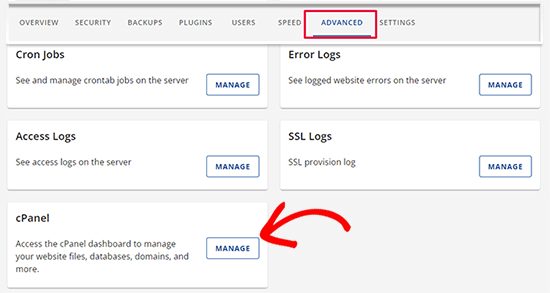
Spowoduje to otwarcie kokpitu cPanel.
Przewiń w dół do sekcji Bazy danych i kliknij opcję „Bazy danych MySQL”.

Uwaga: Twój panel sterowania hostingu może wyglądać nieco inaczej niż na zrzutach ekranu. Jednak nadal powinieneś być w stanie znaleźć sekcję Bazy danych z opcją tworzenia nowej bazy danych.
Wystarczy podać nazwę twojej bazy danych, a następnie kliknąć przycisk „Utwórz bazę danych”.
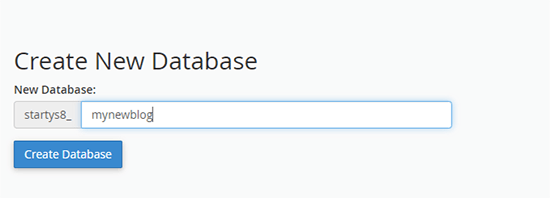
cPanel utworzy teraz nową bazę danych. Następnie należy przewinąć w dół do sekcji Użytkownicy MySQL.
Następnie podaj nazwę użytkownika i hasło dla twojego nowego użytkownika i kliknij przycisk „Utwórz użytkownika”. Pamiętaj, aby zanotować nazwę użytkownika i hasło w bezpiecznym miejscu.
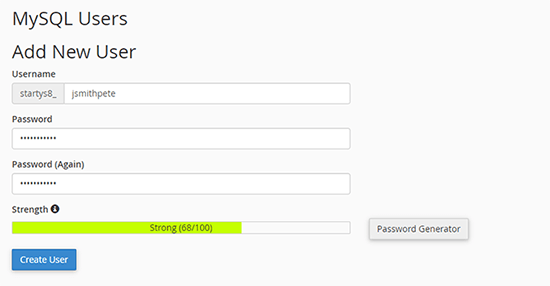
Nowy użytkownik, którego właśnie utworzyłeś, nadal nie ma uprawnień do pracy na bazie danych. Zmieńmy to.
Przewiń w dół do sekcji „Dodaj użytkownika do bazy danych”. Najpierw wybierz utworzonego użytkownika bazy danych z menu rozwijanego obok pola „Użytkownik”. Następnie wybierz utworzoną przed chwilą bazę danych i kliknij przycisk „Dodaj”.
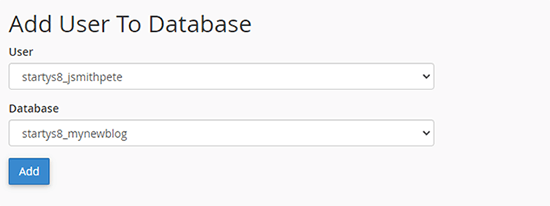
Następnie zostaniesz poproszony o wybranie uprawnień dla użytkownika.
Wybierz „Wszystkie uprawnienia” i kliknij przycisk „Wprowadź zmiany”, aby kontynuować.

Twoja baza danych jest teraz gotowa i może być użyta do przeniesienia WordPressa na nową nazwę domeny.
Zanotuj nazwę bazy danych, nazwę użytkownika i hasło. Informacje te będą potrzebne w następnym kroku.
Krok 3: Rozpakuj WordPress na twoją nową nazwę domeny
Teraz musisz przesłać pobrane wcześniej pliki Duplicator do twojej nowej domeny.
Pakiet Duplicator obejmuje również twoją instalację WordPress. Oznacza to, że nie musisz instalować WordPressa na twojej nowej domenie.
Najpierw połącz się z twoją domeną za pomocą klienta FTP. Po połączeniu upewnij się, że katalog główny twojej witryny internetowej jest całkowicie pusty.
Następnie można przesłać archiwum i pliki instalatora do katalogu głównego. Zazwyczaj nazywa się on public_html.
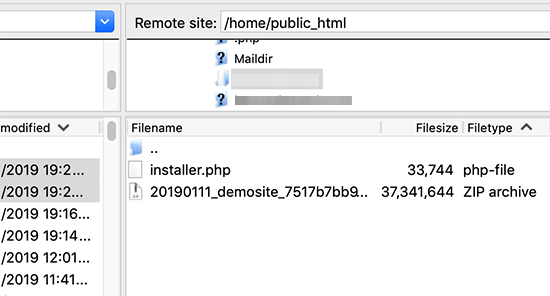
Po zakończeniu przesyłania obu plików możesz teraz rozpakować WordPress.
Otwórz nową kartę przeglądarki i przejdź pod następujący adres URL:
http://example.com/installer.php
Nie zapomnij zastąpić example.com twoją nową nazwą domeny. Spowoduje to uruchomienie kreatora migracji Duplicator.

Instalator wyszuka plik archiwum, a następnie automatycznie wybierze opcje na ekranie.
Przewiń nieco w dół, aby wpisz informacje dotyczące bazy danych utworzonej w poprzednim kroku.
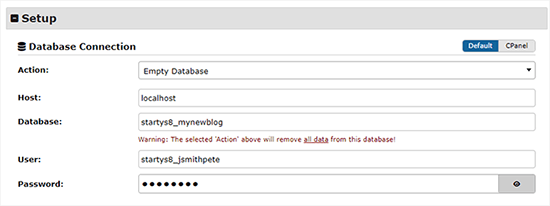
Następnie Duplicator automatycznie wyświetli adres URL twojej starej i nowej domeny.
Jeśli wszystko wygląda dobrze, kliknij przycisk „Zatwierdź”, aby kontynuować.
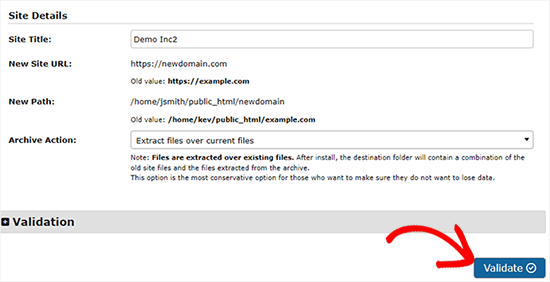
Duplicator podejmie teraz próbę połączenia się z bazą danych przy użyciu podanych informacji.
Po pomyślnym zakończeniu wyświetli się komunikat Validation Pass. W przeciwnym razie zostanie wyświetlone ostrzeżenie ze szczegółowymi informacjami na temat poprawki.

Kliknij przycisk „Dalej”, aby kontynuować.
Duplicator rozpocznie teraz importowanie twojej witryny internetowej WordPress. Po zakończeniu pojawi się komunikat o powodzeniu z przyciskiem logowania administratora.
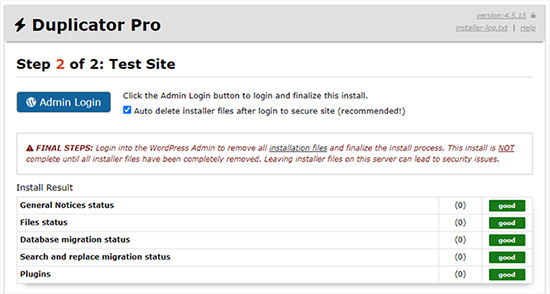
Duplicator automatycznie zaktualizuje adresy URL do twojej nowej nazwy domeny. Możesz teraz kliknąć przycisk „Admin Login”, aby wykonać kolejne kroki.
Krok 4: Ustaw trwałe przekierowania 301
Następnym krokiem jest skierowanie użytkowników odwiedzających twoją starą domenę na nową. Odbywa się to poprzez ustawienie przekierowań 301.
Przekierowania 301 są bardzo ważne dla SEO i doświadczenia użytkownika. Dodanie ich pozwoli na automatyczne przekierowanie użytkowników i wyszukiwarek na twoją nową nazwę domeny.
Innymi słowy, za każdym razem, gdy ktoś wyląduje na wpisie lub stronie w twojej starej domenie, zostanie automatycznie przekierowany do tego samego wpisu lub strony w nowej domenie, zamiast widzieć błąd 404.
Aby utrzymać przekierowania na miejscu, musisz włączyć starą instalację WordPress, aby mogła nadal przekierowywać do nowej, właśnie utworzonej.
Istnieją dwa sposoby konfiguracji przekierowań. Pierwsza metoda jest łatwa i wymaga zaledwie kilku kliknięć. Druga metoda wymaga ręcznej edycji plików.
Metoda 1: Skonfiguruj przekierowania 301 za pomocą All in One SEO
Do tej metody będziesz potrzebował All in One SEO (AIOSEO). Jest to najlepsza wtyczka WordPress SEO na rynku, która pozwala łatwo zoptymalizować twoją witrynę internetową WordPress pod kątem SEO.
Po pierwsze, musisz zainstalować i włączyć wtyczkę All in One SEO na twojej starej domenie. Aby uzyskać więcej informacji, zobacz nasz przewodnik krok po kroku, jak zainstalować wtyczkę WordPress.
Uwaga: Aby uzyskać dostęp do dodatku menedżera przekierowań, wymagana jest co najmniej wersja Pro wtyczki. Możesz również skonfigurować AIOSEO na twojej nowej witrynie WordPress, aby jeszcze bardziej zwiększyć rankingi wyszukiwarek i ruch.
Po włączaniu na twojej starej domenie, musisz przejść na stronę All in One SEO ” Redirects i kliknąć przycisk „Activate Redirects”.
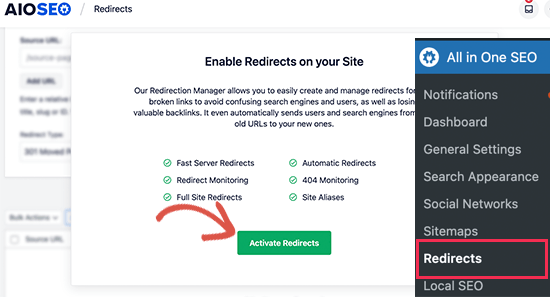
Następnie należy przejść do karty „Pełne przekierowanie witryny” i włączyć przełącznik „Przenieś witrynę”.
Następnie musisz wpisz twoją nową nazwę domeny obok opcji „Przenieś do domeny”.

Nie zapomnij kliknąć przycisku „Zapisz zmiany”, aby zapisać twoje ustawienia.
Metoda 2: Ręczna konfiguracja przekierowań do nowej domeny
Ta metoda wymaga edycji pliku .htaccess WordPressa na twojej starej domenie.
Najpierw należy połączyć się z twoją starą witryną za pomocą FTP i edytować plik .htaccess.
Będzie on znajdował się w tym samym katalogu, co twój katalog wp-includes lub wp-admin. Otwórz plik .htaccess i wklej następujące linie kodu na samej górze:
#Options +FollowSymLinks
RewriteEngine on
Unchanged: RewriteRule ^(.*)$ http://www.newsite.com/$1 [R=301,L]
Upewnij się, że w powyższym kodzie zastąpiłeś newsite. com twoją nową domeną.
Po wprowadzeniu tych zmian przejdź na twoją starą domenę. Powinna ona automatycznie przekierować Cię do nowej domeny.
Jeśli tak się nie stanie, oznacza to, że przekierowanie nie jest skonfigurowane prawidłowo, a twój serwer prawdopodobnie nie obsługuje reguł przekierowań. Musisz skontaktować się z zespołem pomocy technicznej w twojej firmie hostingowej, aby włączyć RewriteEngine.
Krok 5: Powiadom Google o twojej nowej domenie
Teraz, gdy przeniosłeś WordPressa na nową nazwę domeny i skonfigurowałeś przekierowania, nadszedł czas, aby powiadomić Google o twojej zmianie adresu. Pomoże to Google szybko znaleźć twoją nową domenę witrynową i zacząć wyświetlać ją w wynikach wyszukiwania.
Po pierwsze, musisz upewnić się, że zarówno twoja nowa, jak i stara domena zostały utworzone w Google Search Console jako dwie różne właściwości. Instrukcje znajdują się w kroku 1 naszego przewodnika po Google Search Console.
Następnie należy wybrać starą nazwę domeny jako włączoną właściwość w kokpicie Twojego konta Google Search Console.
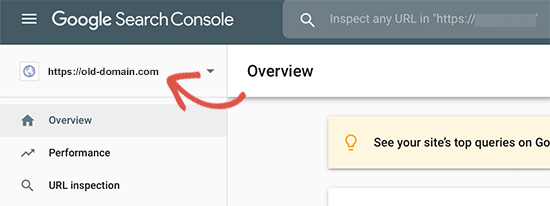
Następnie kliknij menu Ustawienia w lewej kolumnie.
Teraz możesz kliknąć narzędzie „Zmiana adresu”.

Teraz musisz wybrać twoją nową domenę z sekcji Aktualizuj Google.
Następnie należy kliknąć przycisk „Zatwierdź i zaktualizuj”.
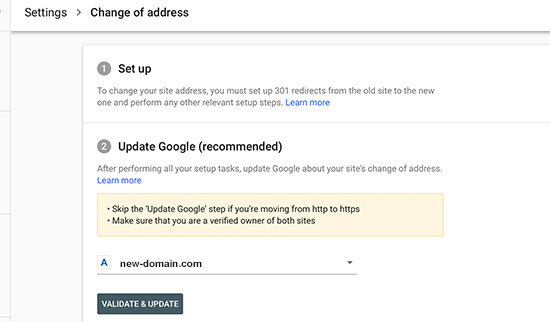
To wszystko. Google potwierdzi teraz, że twoja stara domena przekierowuje do nowej domeny i zapisze zmiany.
Na następnym ekranie Google Search Console wyświetli kreator krok po kroku, aby przesłać twój wniosek o zmianę adresu.
Powiadom swoich użytkowników o nowej nazwie domeny
Podczas gdy przekierowania 301 wykonują swoją pracę, zawsze dobrze jest publicznie ogłosić migrację.
Możesz to zrobić po prostu pisząc wpis na blogu o twojej nowej witrynie i udostępniając go na swoich kontach w mediach społecznościowych.
Jeśli posiadasz subskrybentów newslettera e-mail lub powiadomień push, to do nich również powinieneś wysłać ogłoszenie.
Może to być pomocne na wiele sposobów.
Przede wszystkim, twoi użytkownicy z większym prawdopodobieństwem zapamiętają nową domenę, gdy już o niej przeczytają.
Po drugie, możesz poprosić swoich użytkowników, aby dali ci znać, jeśli zauważą jakieś błędy. Sam nie jesteś w stanie przetestować twojej witryny w każdym rodzaju przeglądarki lub środowiska systemowego. Zawsze pomocna jest świeża para oczu.
Mamy nadzieję, że ten poradnik pomógł ci przenieść twoją witrynę WordPress na nową nazwę domeny. Zachęcamy również do zapoznania się z naszym przewodnikiem na temat tego, jak uzyskać bezpłatną domenę e-mail lub naszym wyborem najlepszych usług telefonii biznesowej.
If you liked this article, then please subscribe to our YouTube Channel for WordPress video tutorials. You can also find us on Twitter and Facebook.





Syed Balkhi says
Hey WPBeginner readers,
Did you know you can win exciting prizes by commenting on WPBeginner?
Every month, our top blog commenters will win HUGE rewards, including premium WordPress plugin licenses and cash prizes.
You can get more details about the contest from here.
Start sharing your thoughts below to stand a chance to win!
Moinuddin Waheed says
When we migrate our blog to the new domain name and all the files and database gets into its new domain , how long does it take for Google to know that it has to rank this new domain?
Also old domain names have domain authority and new domain names will take time to build a domain authority, how does seo remain unaffected if we switch to new domain?
WPBeginner Support says
The 301 redirects are what tell Google to take note of the new domain. There is no specific timeline for when Google will update but as Google crawls the 301 redirects it will redirect and update your listing in search results. While your old links rank they will also redirect to the new location.
Administrator
Moinuddin Waheed says
Thanks for the reply and clarification about the query.
I think after some time of the full setup to the new domain, isn’t it prudent to completely close the old domain and focus on new domain.
or is it better to let 301 redirect continuously redirects to the posts and page and in the meantime when we fully satisfy that all old domain requests are redirects to new one, only then we take decision to stop old domain.
WPBeginner Support says
You would want to check the analytics for the old domain, if you are still getting a good amount of traffic to that domain that is being redirected then you would keep the old domain active, if you are not getting visits to your old domain you would then look to close it.
WPBeginner Support says
If you reach out to your host they can sometimes help and temporarily override their upload limits to get your files into your hosting.
Administrator
Jackie says
What if my file size to be uploaded is over the max 500MB, and I am using Bluehost to upload the files?
Moinuddin Waheed says
for redirecting to new domain, it is better to use the plugin itself that you have suggested i.e all in one seo which is easy to do for all with no coding knowledge people.
And as for accessing the .htaccess file and manually changing it to redirect is somewhat only technical expertise people will look forward to.
Don says
Hi, thank you so much for your guide. We our doing a rebranding resulting in a name change and new url. Our WP administrator will be doing the migration and 301 redirect. Aside from notifying our database and social media followers in our newsletter, I am wondering if we can create a landing page on the new site for the redirects that announces the rebranding, and then segues into the new site after a preset interval.
WPBeginner Support says
If you wanted to instead of redirect 1 to 1 the articles, you could certainly redirect the entire site to a landing page.
Administrator
Unarine Leo Netshifhefhe says
My website has been hacked and I haven’t really gotten time to fix it that much, I would like to know if this problem of it been hacked has some kind of effect on SEO? Does it affect it badly? And my website stops appearing?
WPBeginner Support says
It would depend on if anything changed on the front-end of your site but it can have a negative effect on your site’s SEO.
Administrator
Simon says
How do I use FTP client to connect my domain?
WPBeginner Support says
You would not use FTP for your domain, you would want to use the tools in either your domain registrar or hosting provider.
Administrator
Manu Philip says
Thank you ! It helped a lot
WPBeginner Support says
Glad our guide was helpful!
Administrator
Saifullah Tamim says
Many Many thanks brother. This article is very helpful.
WPBeginner Support says
Glad our guide was helpful!
Administrator
Sajid says
for how many days I need to keep the old site running. For 301 redirection
WPBeginner Support says
There is no universal answer for every site, it would depend on your site and audience but if you wanted to be safe a year is normally long enough for users who would revisit your site to see the change especially if they check your site for seasonal content.
Administrator
James says
Hello, I hope you are doing good. How about migrating a subdomain to a completely new domain name ? For example, migrating „example.blog.com” to „example.com”.
WPBeginner Support says
You can still use this method for moving from a subdomain to a completely new domain
Administrator
ronald says
we still are using our existing site for some things, but not for blogs. these were migrated. we set up 301 redirects and all working smoothly but curious… after migration, with 301 redirects all set up on old server, should we unpublish the posts on old server so they no longer are on old sitemap?
WPBeginner Support says
If you plan to continue to use your old site for other uses then it would normally be best to remove the content you’ve set up redirects for.
Administrator
thierry says
Thanks a lot for this piece, following thes instructions was really clear and everything went smooth without any problems thanks thanks and thanks!
WPBeginner Support says
Glad our guide was helpful!
Administrator
Mark says
Thank you. I tried so many other plugins and techniques – none worked very well.
Although crazy complex for a simple thing this is a great technique. After nuking my earlier attempts this one fixed everything. Fonts, images, thumbnails, etc.
Thank you.
WPBeginner Support says
Glad our guide could help simplify the process in a way that worked for you
Administrator
Manas Patil says
Hello, this article was of great help. Thanks a ton!
But I’d to ask – since I’ve one SSL certificate, I thought I’d move the SSL from my old site to my new site. If I do move it, should it cause any errors while I redirect from my old site to new site?
Thanks in advance!
Manas
WPBeginner Support says
You would want to check with your hosting provider as some have methods to help prevent any errors when changing domains on the same host if they only have one SSL certificate. In general, it should not cause any issues if set up properly.
Administrator
Manas Patil says
Thanks a ton! I managed to move my site completely. Towards the end of the Search Console part, is it necessary to submit the sitemap again – because I don’t see my previous sitemap submissions on my new domain property.
WPBeginner Support says
If you haven’t submitted a sitemap for the new domain you would want to do so to help Google crawl your URLs
BIKRAMJIT KONWAR says
Hi, many thanks for the article. I have a confusion here, can I migrate my WordPress site to a new domain without migrating the existing theme as I want to change the theme?
Amir says
Hello
After migration to new domain, how should i send new post on my site ? Send a new post on old domain or new domain?
Md Shuaib Raza says
Can i delete and cancle my old domain name by provoider after migration?
Paco says
I’m moving to a new domain name, but I’m still going to use the old domain name for other purposes. I don’t want to redirect the entire oldsite to newsite. What’s the recommended way in this case? Thanks.
Hassan says
It helped me a lot, my question is in ftp I will enter my new domain name and user name and password, then you said the installer file and archive file the installer file is it the wordpress zipp file or something else?
WPBeginner Support says
The installer file would be what you downloaded from the Duplicator plugin.
Administrator
F NIc says
Hi, thank you for this detailed guide. I intend to switch domain from Bluehost to GoDaddy and I am wondering if my wordpress website will be affected in terms of how it will look after the switch.
WPBeginner Support says
Your hosting provider would not affect how your site looks, as long as there are no issues with the duplication process the site should look the same.
Administrator
Sachin says
I have a question, I have single web hosting, so how can I move from the old domain to the new domain?
WPBeginner Support says
If you are staying on the same host, you would first want to check with your hosting provider as some have tools to help with changing your site’s domain.
Administrator
Andy says
I’m having a little trouble with Step 5. Notifying Google About the Change.
When I filed the change of address (the Search Console seems to have changed since you wrote this post, but I figured out the new procedure OK), the validation failed because Google couldn’t fetch the home page for my old site.
WPBeginner Support says
Thank you for letting us know, for this situation, you would want to point Google to your new site for it to test the redirects.
Administrator
Sharon says
Thank you so much for this tutorial it was so easy for me to redirect my old domain
WPBeginner Support says
Glad our guide was helpful
Administrator
amir says
can I delete the old host and domain after I did all the steps? or I should renew the host and domain after then
Thanks
WPBeginner Support says
It is normally a good idea to redirect the old domain to the new one for some time but you can end the old hosting and still redirect the old domain if you wanted.
Administrator
Dejan says
Hi Wpbeginner!
Very good article as usual, i have a question just to double check, will all paths be changed? For example media links and so on? Thanks again
WPBeginner Support says
Using this method, your links to images and other media should be updated as well.
Administrator
dariu says
Thanks for this. What is the difference for migrating to new host (and domain)? Is there any difference in steps and instructions?
WPBeginner Support says
You would use the same steps for a new host as well.
Administrator
Penny says
I had to put in mine in the public_html folder to work. Very frustrating at first until I tried that!
Jose says
Thanks for a great tutorial!
I’ve ran into a quirk after following all the steps.
My site redirects everything EXCEPT the content of the home page.
I updated the name servers about two days ago.
I did the redirection via .htaccess.
I’m not sure where to look to troubleshoot the issue. Any direction is appreciated. Thanks again!
WPBeginner Support says
We would recommend checking for any caching plugins as well as reaching out to your hosting provider for the most common reasons for that issue and your hosting provider can normally take a look from their end as well.
Administrator
Jose says
Following up.
I was/am using W3 Total Cache.
Before I migrated, I forgot to disable caching. And that caused issues.
After the migration, I had to manually remove W3 Total Cache in order to get the new site working again.
There was a section of caching code left over in the new .htaccess file.
All has been good since then!
WPBeginner Support says
Glad you were able to get the issue sorted
Haitham says
Hi,
Great tutorial. I have to ask about the SSL redirects since it may cause issues for domains that use cloudflare for instant.
So while adding the code on the .htaccess file in the old website how do I add a newwebsite.com/1$ to that command ?
WPBeginner Support says
If you mean how to update your site to a new domain using a CDN like Cloudflare, we would recommend reaching out to the CDN you are using for their current methods for that kind of change.
Administrator
Joe says
In the last step you mentioned „notify google about the change”.
But what if don’t notify Google about the change, just move the website to new domain, and remove all the pages from old domain (as my website is new and doesn’t have any organic traffic)?
Is it valid?
WPBeginner Support says
You can do that if you want but you would likely take a negative hit in your search engine rankings.
Administrator
Jay Dee says
I have a question about subscribers the website who have created profiles. Would I have to do redirects for their individual profile pages ?
WPBeginner Support says
If you are using the same systems then you shouldn’t need an additional redirect unless the tool you are using says so.
Administrator
Rajesh says
I have a question, I already set 301 redirection, and all the request to the old site is redirecting, now my question is, when I can delete old site and its content permanenty?
WPBeginner Support says
After you create your redirects you can remove the old content.
Administrator
Morgan says
Hello, please I’m confused on this sentence „Once connected, make sure that the root directory of your website is completely empty.”
How can make the root directory to be empty cause is showing some files and folders. Please I need an answer on how to do that. Thanks
WPBeginner Support says
You can either use FTP or some hosts have file managers you can use to delete the folders or you can reach out to your host for assistance
Administrator
Braeden says
Thanks for this! How would you handle domain1 is moving to domain2, but, many of the URL slugs on domain1 are different on domain2. For example, domain1/this-is-a-post/ will be going to domain2/this-is-the-new-post/
WPBeginner Support says
It would depend on the specific changes but depending on how drastic the change you may need to manually set up the individual redirects.
Administrator
Marco says
Thank you for this guide. It helped me.
I tried the 301 redirect on htaccess. However it only redirects the homepage. Any chance for help? Thanks
WPBeginner Support says
You may want to try clearing your caching and checking with your hosting provider to ensure they don’t see any errors on their end.
Administrator
Gosia says
This is great if moving a complete old site to a new domain. But what to do to when you are setting up a new site and want to move over only a few posts from the first site? I don’t want to lose organic traffic.
WPBeginner Support says
You can check under Tools>Export and select the specific posts you want to transfer to your site.
Administrator
Alexandre says
Thanks a lot for this tuto.
I don’t understand why we have to set up permanent 301 redirects if I keep the same domain name ?
Thank for your answer,
Alex
WPBeginner Support says
This article is for moving a site to a new domain name. If you only want to change hosting providers, you would want to take a look at our article below:
https://www.wpbeginner.com/wp-tutorials/how-to-move-wordpress-to-a-new-host-or-server-with-no-downtime/
Administrator
Alexandre says
Sorry, thanks a lot.
You blog posts have always helped me a lot
WPBeginner Support says
Glad our guides have been helpful
Prasad Rane says
Hey thanks a lot for this step by step tutorial.I was able to move clients site in just 30 mins. He was surprised. Thanks a lot.
WPBeginner Support says
Glad our guide could help
Administrator
Luiz Pedao says
Hello, got a bit of a problem here. I transferred my good php and zip files to the public directory, and yet when I browse to mydomain/installer.php it just doesn’t find the page. What could be the problem?
Thanks in advance
WPBeginner Support says
You may want to reach out to your hosting provider to ensure the domain is set up to the correct location that you’re adding the files.
Administrator
Razi says
Thanks, Buddy, After reading your article It’s just like the peace of cake
WPBeginner Support says
Glad our article could be helpful
Administrator
hassan says
GOOD guide.
but if I want to change my URLs in a new domain
my post in the old domain is: oldedoman.com/best-products-2020/
I want to change to newdomain.com/best-products/
How to redirect all my posts
Thanks
WPBeginner Support says
For that type of change, you would need to create manual redirects following our guide below:
https://www.wpbeginner.com/beginners-guide/beginners-guide-to-creating-redirects-in-wordpress
Administrator
Adrian Filip says
Brilliant tutorial. Thank you! Work like a charm!
WPBeginner Support says
Glad you found our guide helpful
Administrator
Megan says
Does this process work with a bluehost basic account? I have purchased my new domain but can’t assign it as an Addon domain since I can only have 1 website. What is the best way to work with this?
WPBeginner Support says
If you’re unable to create an addon domain we would recommend reaching out to your host and some offer support or different ways to set it up.
Administrator
Megan says
Does this method work if I am using the Bluehost Basic plan where I can only have one website? I can’t make my new domain an add on domain.
WPBeginner Support says
You can move from a host to BlueHost’s basic plan following this guide
Administrator
Utsav says
Hi,
I have questions that where to use 301 redirect, in new domain .htaccess or old domain .htaccess.
In my case I have changed my website domain as well as web hosting. Then where to apply 301 redirect and how many time I should active my old domain and hosting active?
WPBeginner Support says
You would want to add 301 redirects to the old domain. It depends on your old site and personal preference for how long you should keep the old domain active but you shouldn’t need the old hosting.
Administrator
Suchitha says
I earlier had my domain in a WordPress site that I do not own. I developed my website there. Now, I have moved my domain to a new WordPress site that I own and also used the Export/Import option to transfer my content to the new site. However, I am having to re-design my website again. Does the procedure mentioned here ensure that my site is transferred intact?
WPBeginner Support says
The method in this guide should let you keep your theme and plugins how they are set up.
Administrator
Adz says
Hi, thanks for sharing.
Once I’ve successfully migrated my old website to the new domain, will the 301 redirect continue to redirect even after ive deleted my old website? The reason I’m asking is because I have several posts on facebook that point to my old site.
WPBeginner Support says
As long as the redirect remains in your htaccess file it will continue to redirect to your site.
Administrator
Ejimurphy says
After moving the the old site to new site, do I still need to purchase new SSL certificate or the SSL certificate for old site will work for the new site
Thanks!
WPBeginner Support says
Most hosts should offer Let’s Encrypt as a free option but you would need to set up SSL for your new domain.
Administrator
Mark says
Perfect! Thank you for a great post!
WPBeginner Support says
You’re welcome
Administrator